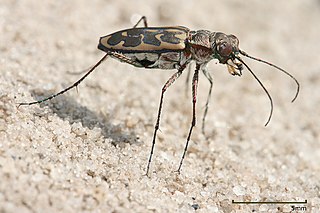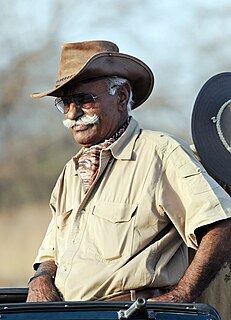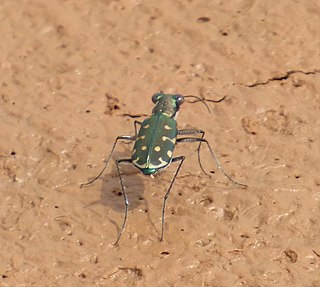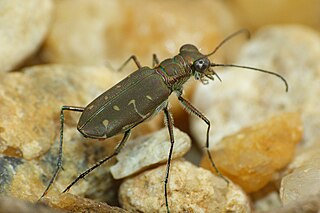
The tiger is the largest living cat species and a member of the genus Panthera. It is most recognisable for its dark vertical stripes on orange fur with a white underside. An apex predator, it primarily preys on ungulates, such as deer and wild boar. It is territorial and generally a solitary but social predator, requiring large contiguous areas of habitat to support its requirements for prey and rearing of its offspring. Tiger cubs stay with their mother for about two years and then become independent, leaving their mother's home range to establish their own.

The Bengal tiger is a population of the Panthera tigris tigris subspecies. It ranks among the biggest wild cats alive today. It is considered to belong to the world's charismatic megafauna.

Tiger beetles are a family of beetles, Cicindelidae, known for their aggressive predatory habits and running speed. The fastest known species of tiger beetle, Rivacindela hudsoni, can run at a speed of 9 km/h, or about 125 body lengths per second. As of 2005, about 2,600 species and subspecies were known, with the richest diversity in the Oriental (Indo-Malayan) region, followed by the Neotropics. While historically treated as a subfamily of ground beetles (Carabidae) under the name Cicindelinae, several studies since 2020 indicated that they should be treated as a family, the Cicindelidae, which are a sister group to Carabidae within the Adephaga.

The lion-tailed macaque, also known as the wanderoo, is an Old World monkey endemic to the Western Ghats of South India.
Ranthambore National Park is a national park in Rajasthan, India, with an area of 1,334 km2 (515 sq mi). It is bounded to the north by the Banas River and to the south by the Chambal River. It is named after the historic Ranthambore Fort, which lies within the park.

Pilibhit district is one of the 75 districts in the state of Uttar Pradesh in India, and Pilibhit city is the district headquarters. Pilibhit district is a part of Bareilly Division. A Tiger Reserve Area was named Pilibhit Tiger Reserve in September 2008.

Mudumalai National Park is a national park in the Nilgiri Mountains in Tamil Nadu, south India. It covers 321 km2 (124 sq mi) at an elevation range of 850–1,250 m (2,790–4,100 ft) in the Nilgiri District and shares boundaries with the states of Karnataka and Kerala. A part of this area has been protected since 1940. The national park has been part of Nilgiri Biosphere Reserve since 1986 and was declared a tiger reserve together with a buffer zone of 367.59 km2 (141.93 sq mi) in 2007. It receives an annual rainfall of about 1,420 mm (56 in) and harbours tropical and subtropical moist broadleaf forests with 498 plant species, at least 266 bird species, 18 carnivore and 10 herbivore species. It is drained by the Moyar River and several tributaries, which harbour 38 fish species.

The Dudhwa National Park is a national park in the Terai belt of marshy grasslands in northern Uttar Pradesh, India. It stretches over an area of 490.3 km2 (189.3 sq mi), with a buffer zone of 190 km2 (73 sq mi). It is part of the Dudhwa Tiger Reserve in the Kheri and Lakhimpur districts. The park is located on the Indo-Nepali border in the Lakhimpur Kheri District, and has buffers of reserved forest areas on the northern and southern sides. It represents one of the few remaining protected areas of the diverse and productive Terai ecosystem, supporting many endangered species, obligate species of tall wet grasslands and species of restricted distribution.

Panna National Park is a national park located in Panna and Chhatarpur districts of Madhya Pradesh in India. It has an area of 542.67 km2 (209.53 sq mi). It was declared in 1994 as the twenty second Tiger reserve of India and the fifth in Madhya Pradesh, Panna was given the Award of Excellence in 2007 as the best maintained national park of India by the Ministry of Tourism of India. It is notable that by 2009, the entire tiger population had been eliminated by poaching with the collusion of forest department officials.

Nagarahole National Park is a national park located in Kodagu district and Mysore district in Karnataka, India.

The Indian leopard is a leopard subspecies widely distributed on the Indian subcontinent. The species Panthera pardus is listed as Vulnerable on the IUCN Red List because populations have declined following habitat loss and fragmentation, poaching for the illegal trade of skins and body parts, and persecution due to conflict situations. The Indian leopard is one of the big cats occurring on the Indian subcontinent, along with the Asiatic lion, Bengal tiger, snow leopard and clouded leopard. In 2014, a national census of leopards around tiger habitats was carried out in India except the northeast. 7,910 individuals were estimated in surveyed areas and a national total of 12,000–14,000 speculated.
The Wildlife Institute of India (WII), an autonomous natural resource service institution under the Ministry of Environment Forest and Climate change, Government of India, was established in 1982. WII carries out wildlife research in areas of study like Biodiversity, Endangered Species, Wildlife Policy, Wildlife Management, Wildlife Forensics, Spatial Modeling, Ecodevelopment, Ecotoxicology, Habitat Ecology and Climate Change. WII has a research facility which includes Forensics, Remote Sensing and GIS, Laboratory, Herbarium, and an Electronic Library. The founder director was V. B. Saharia while the first Director was Hemendra Singh Panwar who remained the director from 1985 to 1994. Trained personnel from WII have contributed in studying and protecting wildlife in India. The national tiger census or the All India Tiger Estimation, is done by WII along with NTCA and state forest departments.

The Dudhwa Tiger Reserve is a protected area in Uttar Pradesh that stretches mainly across the Lakhimpur Kheri and Bahraich districts and comprises the Dudhwa National Park, Kishanpur Wildlife Sanctuary and Katarniaghat Wildlife Sanctuary. It covers an area of 1,284.3 km2 (495.9 sq mi) and includes three large forest fragments amidst the matrix dominated by agriculture. It shares the north-eastern boundary with Nepal, which is defined to a large extent by the Mohana River. The area is a vast alluvial floodplain traversed by numerous rivers and streams flowing in south-easterly direction. It ranges in altitude from 110 to 185 m.

Fateh Singh Rathore was an Indian tiger conservationist. Fateh Singh joined the Indian Forest Service in 1960 and was part of the first Project Tiger team. He was widely acknowledged as the tiger guru for his legendary knowledge of the big cat. He worked over 50 years in wildlife conservation. Rathore was noted for his pioneering relocation of villages from inside the Ranthambhore National Park in 1973–75. Largely because of Mr. Rathore, "Ranthambhore became the place which brought the tiger to the consciousness of people the world over."

Satkosia Tiger Reserve is a tiger reserve located in the Angul district of Odisha, India covering an area of 988.30 km².
Hemendra Singh Panwar is an Indian conservationist and civil servant, known for his efforts in the fields of wildlife and conservation. He was the first director of the Wildlife Institute of India and was the director of Project Tiger. The Government of India honoured him, in 2013, with Padma Bhushan, the third-highest civilian award, for his services to the environment and conservation.

Myriochila fastidiosa is a species of tiger beetle found across India and Sri Lanka. The head and pronotum are greenish or coppery and the elytra vary from greenish bronze to coppery. The markings are yellowish. The legs are pale coloured. They are found in open forest and grassland.

Myriochila distinguenda is a species of tiger beetle found in South Asia. It is found mainly on the muddy shoreline around freshwater. The genus Myriochila is characterized by hooked setae on the femora and four hairs on the pale or whitish labrum.

Calochroa hamiltoniana is a species of tiger beetle endemic to the southern Western Ghats of India. It is found only on the shaded floor of dense and moist forests. It is 14 to 17 mm long and has the pronotum and elytra largely greenish or bronze with an orange and black stripe running along the length of the elytra.

Calomera fowleri is a species of tiger beetle endemic to peninsular India. It is found foraging on wet sand and riverine areas in the edges of forests. It is somewhat similar to Calomera angulata but that species is found on open sandy beaches, has bolder markings and longer mandibles.

















